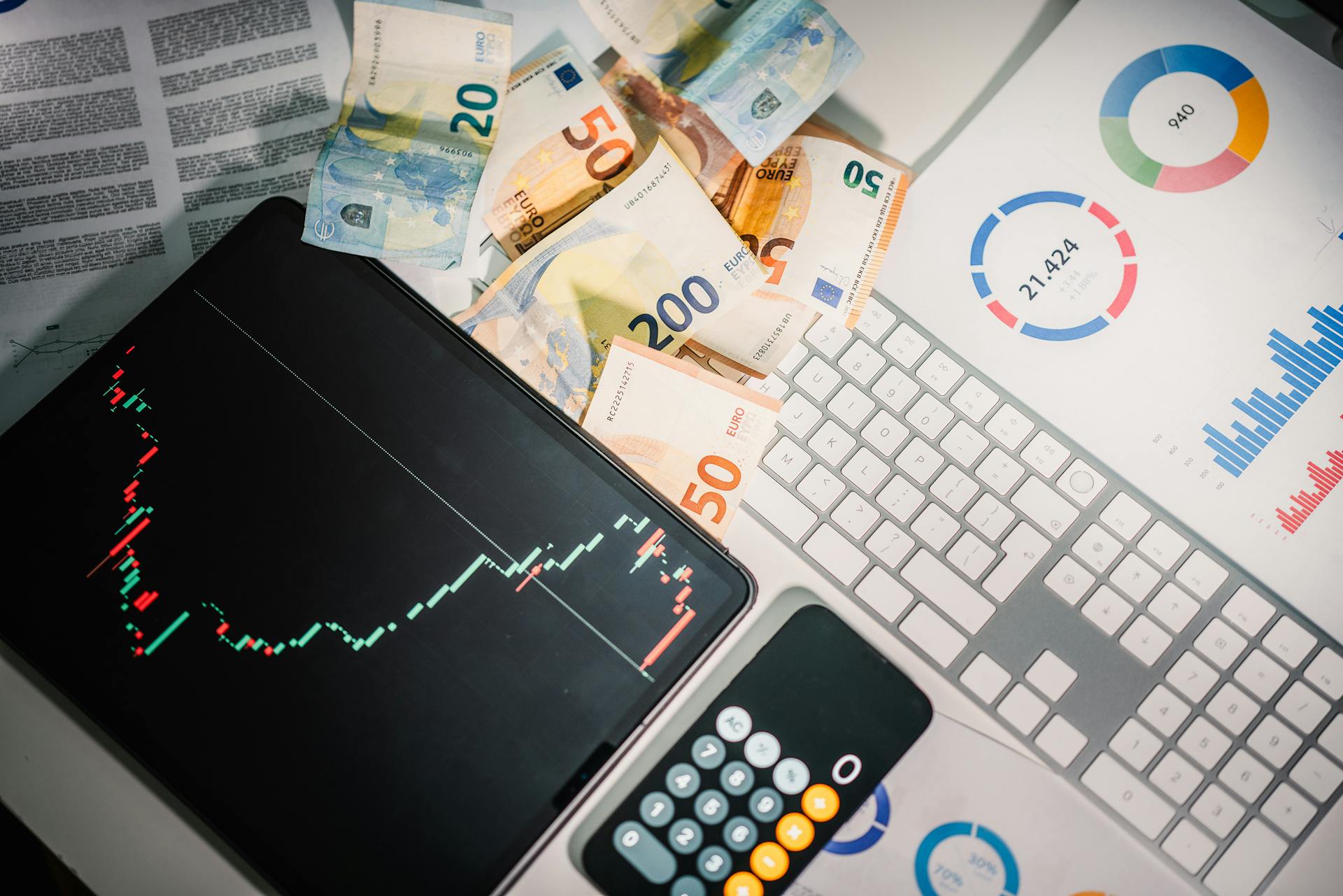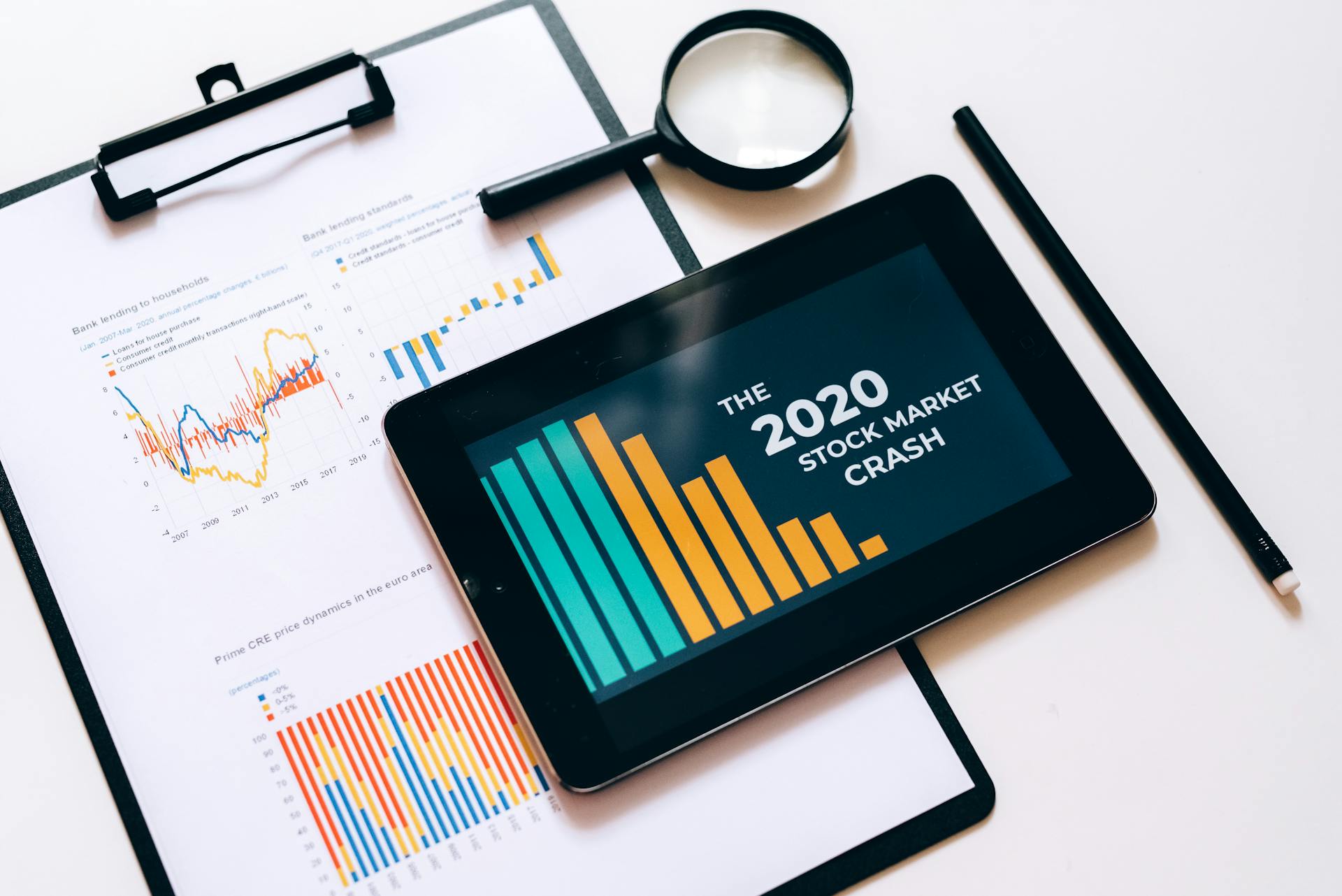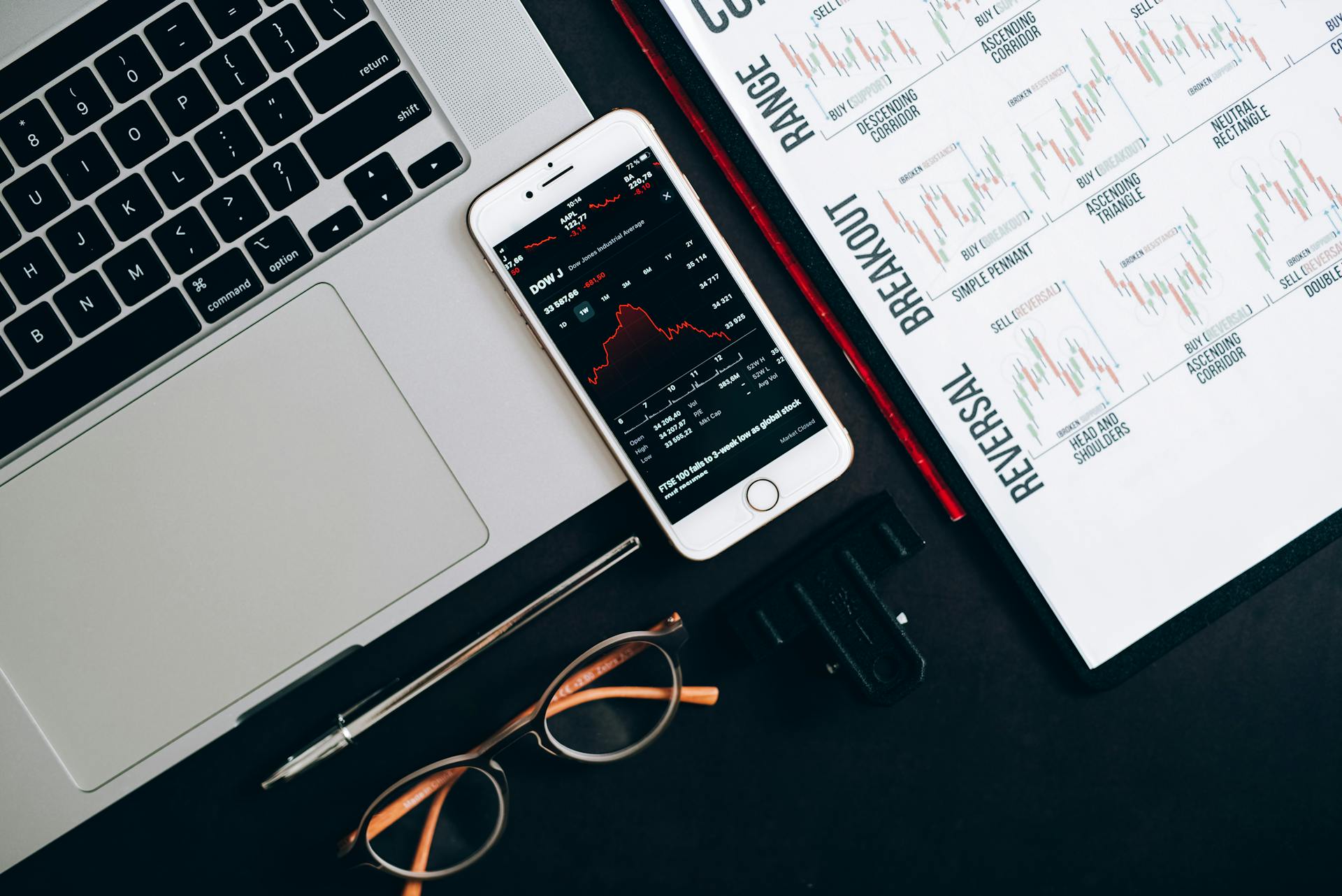
Stock buybacks are a common practice in the business world, where a company uses its cash to repurchase its own shares from the market. This can have a significant impact on the company's stock price and shareholder value.
Companies often use stock buybacks as a way to return value to shareholders and boost their confidence in the company's future prospects. By reducing the number of outstanding shares, the company can increase the value of each remaining share.
The process of a stock buyback typically involves the company announcing its intention to buy back a certain number of shares, and then using cash from its treasury or issuing debt to fund the purchase.
Recommended read: Share Buyback Good or Bad
What Is a Stock Buyback?
A stock buyback is a process where a company repurchases its own shares from the marketplace. This can improve a company's financial ratios, which are used by investors to determine the value of a company.
By decreasing the outstanding shares, a company can increase its earnings per share (EPS). This is a key metric that investors look at to evaluate a company's performance.
Stock buybacks don't actually increase a company's earnings, but they do make its financial metrics look better.
Take a look at this: How Are Stock Speculators Different from Stock Investors
Understanding the Process
A company typically announces a "repurchase authorization" to undertake a stock buyback, detailing the size of the repurchase in terms of shares, percentage of stock, or dollar amount.
This authorization can be for a specific amount of cash, which the company may use or borrow to repurchase stock. Borrowing cash is usually riskier, but it's an option.
A company usually repurchases stock in the public market, buying from any investor who wants to sell, rather than specific owners. This helps treat all investors fairly, since any investor can sell into the market.
Investors are under no obligation to sell their shares just because the company is buying back shares. Management has the prerogative to change its mind, prioritize other needs, or respond to a crisis, which could prevent a stock buyback from happening.
Intriguing read: Chip Stock Investor
Market Manipulation Concerns
The SEC closely monitors stock buybacks to ensure that companies do not engage in market manipulation or other illegal activities. This is a crucial step in maintaining fair market practices.
Stock buybacks can be a complex process, and the SEC wants to make sure companies aren't using them to manipulate the market. This is why they have strict guidelines in place.
The SEC takes market manipulation concerns very seriously, and they have the power to investigate and take action if they suspect wrongdoing.
Benefits and Advantages
Stock buybacks offer numerous benefits and advantages to companies and their stakeholders. Companies can choose when and how many shares to repurchase, giving them flexibility in their financial decisions.
This flexibility is particularly useful for companies that want to maintain financial flexibility for future investment opportunities or to weather economic downturns. By using excess cash for stock buybacks, companies can keep their options open.
Stock buybacks can also improve a company's financial ratios, such as return on equity (ROE) and price-to-earnings (P/E) ratio. Additionally, employees with stock options or equity-based compensation plans may benefit from stock buybacks, as the reduced number of outstanding shares can increase the value of their holdings.
Improve Financial Ratios
Stock buybacks can be a powerful tool for improving a company's financial ratios. By repurchasing shares, companies can increase their return on equity (ROE) and reduce their price-to-earnings (P/E) ratio.
This is because buybacks can boost earnings per share, making the company's financial performance look more attractive to investors. The improved ROE and P/E ratio can also make the company more attractive to potential investors.
For example, a company that repurchases 10% of its outstanding shares can increase its earnings per share by 10%, assuming the same level of earnings. This can lead to a significant improvement in the company's financial ratios.
By making strategic buyback decisions, companies can create a more favorable financial picture, which can have a positive impact on their stock price and overall financial health.
Readers also liked: Trupanion Stock Price
Compensation Plans
Employees with stock options or equity-based compensation plans can benefit from stock buybacks as the reduced number of outstanding shares can increase the value of their holdings.
Stock buybacks can create a conflict of interest for executives with equity-based compensation, who may prioritize buybacks over other initiatives that could benefit the company's long-term growth.
This is because executives with equity-based compensation may see a short-term gain in their own wealth, but may not consider the potential long-term consequences for the company.
Worth a look: Bank of America Share Buyback
Disadvantages and Criticisms
Stock buybacks can have some significant disadvantages and criticisms. One of the main concerns is that they can be used to cover up stock issuance to managers, diluting the ownership of shareholders.
Buybacks can also allow managers to enrich themselves at the expense of shareholders, especially if they have options that become valuable once the stock price reaches a certain level. This can lead to a short-term focus, where companies prioritize share repurchases over long-term investments.
Poorly executed buybacks can also destroy value, as seen when a management team buys stock at a high price, wasting shareholder capital. For example, if a stock is only worth $100 but a management team is buying it for $150, that destroys value.
Take a look at this: Fisv Stock Price
Some critics argue that the money used for buybacks could be better spent on research and development, or on investing in new products and facilities. However, this is up to investors and managers to decide.
Here are some common reasons why buybacks may be bad:
- Buybacks can be used to cover up stock issuance to managers.
- Buybacks may allow managers to enrich themselves at the expense of shareholders.
- Buybacks can be poorly executed, wasting shareholder capital.
- Buybacks can starve the business of money needed for research and development or other investments.
It's worth noting that more than half of all buybacks are financed by debt, which can negatively influence a company's cash flow.
Types of Stock Buybacks
There are several types of stock buybacks, each with its own advantages and disadvantages. One type is the open market buyback, where a company buys back shares at the current market price. This can lead to higher share prices if the market views the buyback as a smart move.
A tender offer is another type of stock buyback. In this case, a company offers to buy back a specific number of shares at a predetermined price, usually higher than the current market price. This provides certainty and speed, but may come with a higher cost and increased volatility.
Companies can choose between these two methods based on their specific needs and goals. For example, a tender offer may be more suitable for a company that wants to quickly reduce the number of shares on the market, while an open market buyback may be more suitable for a company that wants to signal confidence to the market.
Here are some key differences between open market and tender offers:
Open Market Purchases
Open market purchases involve buying back shares on the open market, typically through a broker. This process allows companies to buy back shares at market value, which can be a good indicator of the company's confidence in its future performance.
Companies may choose to buy back shares on the open market as a way to signal to the market that they believe their shares are undervalued. This can lead to a higher share price if the market views the buyback as a smart move.
For your interest: How to Buy Shares of Stock
In open market purchases, prices can often soar up after the announcement since this is seen as a positive indicator. This can be beneficial for existing shareholders, as it can increase the value of their shares.
Companies may prefer open market purchases over other types of buybacks due to the flexibility it offers. Unlike dividends, which once initiated are expected to be maintained or grown, open market purchases provide a one-off return of cash, providing companies with greater financial flexibility.
Here are some key characteristics of open market purchases:
Tender Offers
Tender Offers provide a clear cost structure, allowing companies to set the price and number of shares to be repurchased.
Companies can set the price and number of shares to be repurchased, providing a clear cost structure.
Tender offers can be completed relatively quickly compared to open market purchases.
The share premium may be higher than in open market purchases.
Tender offers require public disclosure, which can impact the stock price and potentially lead to increased volatility.
Here's a comparison of Tender Offers and Dutch Auctions:
Regulations and Compliance
The Securities and Exchange Commission (SEC) regulates stock buybacks to protect investors and maintain fair and orderly markets. This oversight ensures that companies follow strict guidelines to avoid market manipulation.
Companies must adhere to specific corporate governance requirements related to stock buybacks, including board approval and shareholder communication. This ensures transparency and accountability in the buyback process.
To conduct stock buybacks without being accused of market manipulation, companies must follow the safe harbor provisions of Rule 10b-18. These provisions provide a clear framework for companies to repurchase shares without violating securities laws.
Here are the specific requirements for companies to follow:
- Disclose material terms of a Rule 10b5-1 trading plan, including the date of adoption or termination, duration, and aggregate number of shares to be purchased or sold.
- Follow the safe harbor provisions of Rule 10b-18 to avoid allegations of market manipulation.
Tax Implications
Tax implications can be a complex issue, especially when it comes to stock buybacks. The tax treatment of these transactions has been a point of contention, as capital gains from buybacks are generally taxed at a lower rate than dividend income.
In many cases, companies choose to repurchase shares rather than pay dividends to minimize their tax liability. This can be a strategic move, but it's essential to understand the implications for investors and the company itself.
SEC Rules
The Securities and Exchange Commission (SEC) regulates stock buybacks to protect investors and maintain fair and orderly markets.
To ensure compliance, companies must follow specific rules, including Rule 10b-18, which provides a "safe harbor" for companies conducting stock buybacks without being accused of market manipulation.
Companies that follow the safe harbor provisions of Rule 10b-18 are generally protected from allegations of market manipulation related to their stock buybacks.
However, companies and their insiders must adhere to insider trading regulations during stock buybacks to avoid potential legal and regulatory issues.
To maintain transparency, companies must also adhere to corporate governance requirements related to stock buybacks, including board approval and shareholder communication.
Here are the key corporate governance requirements for stock buybacks:
- Board approval
- Shareholder communication
In addition to these requirements, companies must also include a checkbox in their periodic reports to indicate whether certain officers and directors purchased or sold shares within four business days before or after the announcement of a stock buyback plan or program.
Impact on Stakeholders
Stock buybacks can have a significant impact on various stakeholders, including investors, employees, and the company itself.
For investors, stock buybacks can create value in several ways. They can elevate investors' returns significantly, especially when pursued consistently over time. Share buybacks can create value for continuing shareholders if they're purchased for less than their intrinsic value.
For employees, stock buybacks can have varying effects, particularly regarding stock options and compensation plans. Employees may benefit from the increased value of their stock options, but they may also experience dilution if the company issues new shares.
Here are some potential benefits of stock buybacks for stakeholders:
Overall, stock buybacks can be a valuable tool for companies looking to create value for their stakeholders.
Wealth Concentration
Wealth Concentration is a significant concern when it comes to stock buybacks. The benefits of buybacks tend to accrue to wealthy shareholders and corporate executives disproportionately.
Stock buybacks have been criticized for exacerbating wealth concentration and inequality. This is because the cash used for buybacks could be invested in employees, research, or other areas that benefit a wider range of stakeholders.
Wealth concentration can have far-reaching consequences, including reduced economic mobility and a widening wealth gap.
Executive Compensation and Conflicts of Interest
Stock buybacks can create conflicts of interest for executives, particularly those with equity-based compensation plans. This is because executives may be incentivized to prioritize buybacks over other initiatives that could benefit the company's long-term growth.
Executives with stock options or equity-based compensation plans may have a vested interest in stock buybacks, as they can increase the value of their holdings. This can lead to a situation where executives prioritize their own financial gain over the company's long-term success.
Critics argue that stock buybacks exacerbate wealth concentration and inequality, as the benefits tend to accrue to wealthy shareholders and corporate executives disproportionately. This can lead to a widening gap between the rich and the poor.
In some cases, executives may be more focused on short-term gains than long-term growth, which can have negative consequences for the company and its stakeholders.
Impact on Shareholders
As a shareholder, the impact of stock buybacks on your investments can be significant. Stock buybacks can increase shareholder value by raising the stock price, improving financial ratios, and signaling management's confidence in the company's future.
The benefits of stock buybacks can vary depending on factors such as your time horizon and the company's financial performance. If you're a long-term investor, you may be more concerned with the company's overall financial health and growth prospects.
Stock buybacks can have a positive impact on shareholders by creating value for continuing shareholders if the shares are purchased for less than their intrinsic value. This can lead to an increase in the stock's potential upside for shareholders who want to remain owners.
Here are some ways stock buybacks can benefit shareholders:
- Creating value for continuing shareholders if purchased for less than intrinsic value
- Returning cash to shareholders who want to exit the investment
- Increasing earnings per share (EPS) by reducing the number of outstanding shares
- Increasing the stock's potential upside for shareholders who want to remain owners
- Being a more tax-efficient way to return earnings to shareholders compared to dividends
It's worth noting that the benefits of stock buybacks can be more pronounced if a company buys back stock over time, reducing the share count by even 2 or 3 percent each year. This can increase a shareholder's return by a comparable amount each year.
Employees
Employees with stock options may benefit from stock buybacks, as the reduced number of outstanding shares can increase the value of their holdings.
The impact of stock buybacks on employees is not always clear-cut, and it can vary depending on the specific situation.
Employees who have stock options or equity-based compensation plans may see an increase in the value of their holdings due to the reduced number of outstanding shares.
However, other employees may perceive stock buybacks as a sign that the company is prioritizing shareholder returns over other initiatives, which can negatively impact company culture and morale.
Frequently Asked Questions
What does nvidia buyback mean?
Nvidia's buyback program signals to investors that the company believes its stock is undervalued, and buying back stock can increase earnings per share (EPS) by reducing the outstanding share count. This move can have a positive impact on the company's financials and stock price.
What is the 5 year rule for share buy-back?
For basic rate taxpayers, profits from share buy-backs held for at least 5 years are taxed at 18% Capital Gains Tax (CGT). If held for less than 5 years, profits are taxed as dividends.
Do I have to sell my shares in a buyback?
No, you don't have to sell your shares in a buyback. Shareholders can choose to keep their shares, but the company will buy back some of the outstanding shares, reducing the total number of shares in circulation.
Is share buy back good or bad?
A share buyback can be a strategic move to boost stock value by reducing supply, but its impact depends on various factors, including the company's financial health and market conditions. It's essential to consider the motivations and implications of a share buyback before making an investment decision.
What did Warren Buffett say about stock buybacks?
Warren Buffett only buys back shares when he considers them a "bargain," looking for a price below the company's intrinsic value. He prioritizes value over cost, making stock buybacks a strategic move for Berkshire Hathaway.
Sources
- https://www.bankrate.com/investing/stock-buybacks/
- https://www.davispolk.com/insights/client-update/sec-mandates-new-disclosures-stock-buybacks
- https://news.cision.com/africa-oil-corp/r/africa-oil-announces-results-of-share-buyback-program,c4086832
- https://finbold.com/guide/stock-buyback-definition/
- https://www.financestrategists.com/wealth-management/stocks/stock-buybacks/
Featured Images: pexels.com


